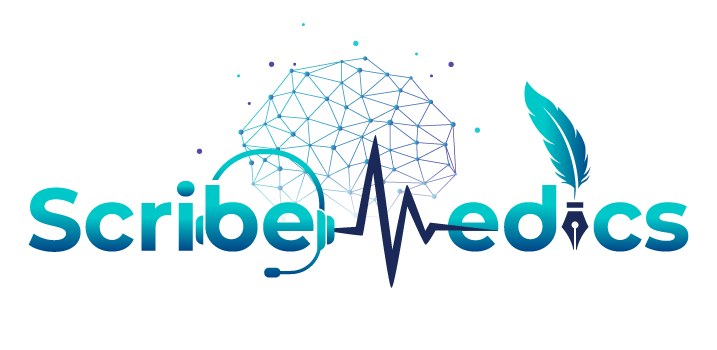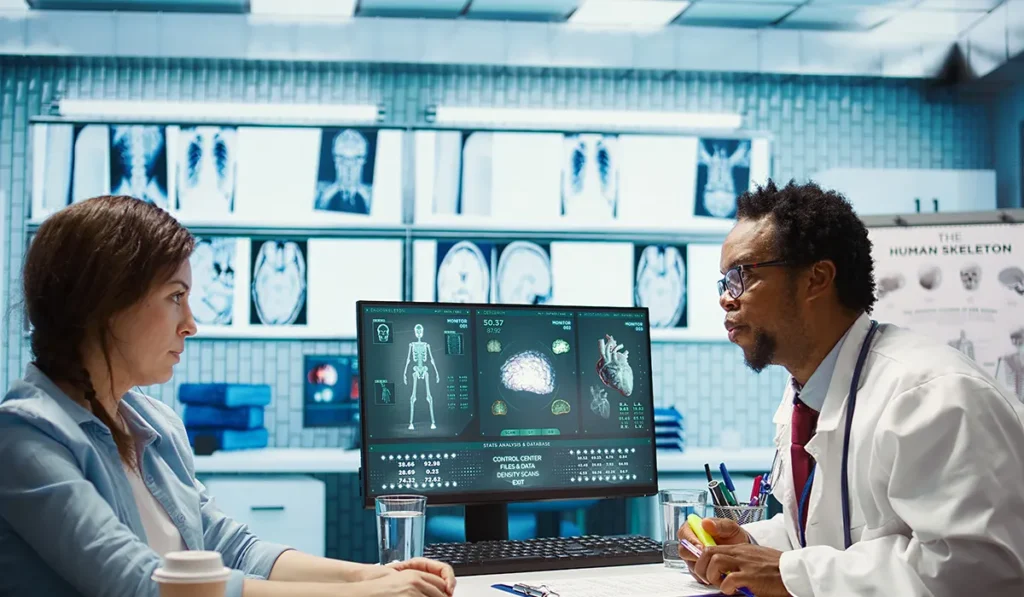The shift from paper records to digital systems has transformed healthcare forever. But as an accompaniment to the process, two words always create misunderstanding: EMR and EHR. While these words are identical in sound, they possess distinct roles in patient care, medical billing services, and healthcare administration in general.
Understanding the EMR vs. EHR debate isn’t just about knowing what each acronym stands for. It’s about knowing how they impact patient care, data accuracy, and even the success of your medical billing agencies and medical coding services in America.
Today, through scribe support, medical transcription services, and remote medical scribe support, doctors and healthcare organizations are better equipped to deal with patient data than before. This blog will walk you through how EMR vs. EHR differ from one another and why this distinction matters for the provider, patient, and medical billing and coding bodies in the United States.
What is EMR?
An Electronic Medical Record (EMR) is the digital version of a patient’s paper chart within a single healthcare practice. Think of it as the modern-day equivalent of a file cabinet in your doctor’s office, except it’s stored on a computer.
In practical terms:
- If you have a doctor locally, your information is stored on their electronic medical record systems.
- That record won’t automatically follow you if you see another doctor outside their network.
EMR meaning is often misunderstood because many assume it works like an EHR. But EMRs are typically practice-specific, focusing on improving internal workflows rather than sharing patient data across multiple locations.
In order to maintain the accuracy of EMR systems, many providers use the services of medical transcriptionists or transcription companies. A medical transcription company in USA turns dictated notes into structured EMR entries, thus ensuring compliance and quality of care.
What is EHR?
An Electronic Health Record (EHR) is an electronic record of health-related information on an individual that follows them everywhere; they also contain all the information that an EMR can contain, such as lab results, diagnoses, allergies, and medications, and additionally allow coordinated care between different health care settings.
With EHR systems, other providers, such as specialists and medical billing agencies, can have access to the same current information. If you go see a cardiologist, they will be able to see your primary care notes in an instant, as well as your electronic healthcare record system updates and hospital discharge summaries, all in real time.
Features of modern electronic health records software often include:
- Patient portal access so that patients may see and edit their information themselves
- One-to-one communication between clinicians and patients through secure messaging
- Incorporation with web-based medical scribe programs for fast and accurate documentation
- Interoperability with pharmacies, laboratories, and insurance networks
As EHRs connect different points of care, duplicate tests decrease, diagnostic times speed up, and medical billing services in America are simplified through a precise correlation of codes and documentation.
EMR vs EHR: The Key Differences
Though often used interchangeably, an EHR vs. EMR varies in scope, usability, and integration. Understanding these differences is essential for making the right choice for your practice, especially if you rely on medical billing agencies or medical billing and coding companies in the United States of America.
This EHR vs. EMR comparison matters because it affects billing efficiency and patient care coordination.
| Factors | EMR | EHR |
|---|---|---|
| Scope | Stores patient data for a single practice or organization | Shares patient data across multiple practices and facilities. |
| Interoperability | Limited to internal use | Fully interoperable between different healthcare providers and systems. |
| Data Sharing | Cannot automatically share with outside providers | Facilitates secure sharing with specialists, pharmacies, laboratories, and hospitals. |
| Patient Access | Typically restricted to records within the organization only | Provides patient portal for up-to-date, real-time access. |
| Billing Integration | Might need distinct systems for medical billing services | Tends to integrate with USA medical billing services for quicker and more precise claims |
| Documentation Support | Works with medical transcription services and transcription firms for information | Supports compatibility with virtual medical scribe services in USA and online medical scribes. |
In brief, EMRs are electronic medical records programs for a single organization, while EHRs represent a digital version of your complete care process as it links the provider, the patient, and the billing personnel in real time.
EMR & EHR in Medical Billing and Coding
Proper electronic health records lay the groundwork for efficient medical coding and medical billing services in USA. If there is incomplete or incorrect documentation, then the claims get rejected, remunerations get postponed, and non-compliance issues emerge. These healthcare delays also have an effect on revenue as well as on the satisfaction of the patient.
The EHR systems support faster, more accurate, and more uniform billing through:
- Connecting the patient’s clinical history to billing codes directly
- Reducing duplicate or incorrect charges before they reach the payer
- Providing medical billing agencies with instant access to up-to-date records
- Assisting outsource medical coding firms apply accurate, compliant codes
For instance, as a remote medical scribe enters information into the record in real time, it becomes available to the coding team so they can process claims fast. This minimizes rejections of the claim, reduces the payment cycle, and ensures financial sustainability for both small practices and top medical billing companies.
Though billing is also possible through EMR systems, they tend to involve additional steps or connectivity with a separate medical billing company in America. This tends to make the process slower and more time-consuming for busy clinics. EHRs, however, integrate seamlessly with virtual scribe medical technologies, online medical scribe services, and even transcription medical services. This makes sure that documentation is always up-to-date, accurate, and code-ready.
In short, if your goal is to streamline documentation and billing and reduce the time between care delivery and payment, moving from an EMR to an EHR with virtual medical scribe services in USA is often the smartest choice. It connects care, documentation, and billing into one smooth, efficient workflow.
Role of Medical Scribes in EMR & EHR Management
Whether you use an EMR or an EHR, efficient and accurate documentation is the key. That’s where the medical scribe steps in. These professionals document patient interactions, edit records, and allow healthcare providers to focus on care delivery instead of data entry.
Providers now have choices of scribe options:
- On-site medical scribe organizations providing in-person documentation assistance
- Virtual or remote scribe assistance for, flexible documentation
- Remote medical scribe solution for telehealth or hybrid practices
Modern healthcare also offers advanced options like the hybrid AI medical scribe, which combines the speed of AI with the precision of human review. For example, ScribeMedics delivers one of the best AI medical scribe solutions in the industry. Their system uses AI medical scribe tools to capture details instantly, while trained professionals, skilled in medical scribe AI workflows, refine the record to ensure accuracy, compliance, and clarity.
This approach ensures that all data from one patient encounter, symptoms, lab results, diagnosis, and plan of treatment, is entered into the EMR or EHR with full continuity. It also allows for medical transcription online entries to be easily integrated into the system, creating one single source of truth for USA medical billing services as well as for patient care.
With the proper blend of technology and human skill, healthcare organizations can maintain accurate, current electronic medical records or electronic health records ready for coding, billing, and collaborative care.
Medical Transcription & Its Connection to EMR vs. EHR
The act of transcribing a healthcare provider’s dictations into written documents is referred to as medical transcription. These documents then become constituents of the electronic medical records or electronic health records of the patient. It is a very vital link between the provider’s comments and the codified data retained in EMR and EHR systems.
Contemporary medical transcription services make sure that all information from a patient encounter history, lab findings, diagnosis, and treatment is neatly and accurately documented. This does more than enhance the quality of care; it also increases the efficiency of medical billing services and medical coding. With clean and concise documentation properly formatted for the EMR vs. EHR, coding groups process claims more quickly and cut through delays and denials.
Healthcare organizations often partner with specialized transcription companies or a medical transcription company in America for this work. These experts understand complex medical terminology, follow strict compliance rules like HIPAA, and deliver accurate transcripts within tight deadlines. Many also provide medical transcription online services, allowing providers to upload audio files securely and receive completed documents ready to integrate with their electronic health record systems.
The connection between transcription and EHR vs. EMR systems is direct:
- For EMRs, transcription updates the record of a single practice for a patient.
- The same transcribed data for EHRs is exchanged between several providers for coordinated care.
With today’s technology, transcription is often combined with virtual scribe medical tools and remote medical scribe support. Some solutions, like the hybrid AI medical scribe from ScribeMedics, can automatically transcribe provider dictations, while human experts review the output for accuracy. This speeds up the workflow and keeps electronic medical records error-free.
By incorporating medical transcription services into your EMR vs. EHR process, you don’t just enhance the quality of documentation but also fortify the link between care delivery, patient engagement, and medical billing services in the USA.
Benefits of EHR vs. EMR for Patients and Providers

Whether you use an electronic medical record system or full electronic health record
EHR software, both bring powerful advantages to healthcare providers and patients. When implemented well and supported by medical scribe services in the USA, medical transcription services, or remote medical scribe teams, these systems can transform care delivery.
1. Enhanced Quality of Care
EMR and EHR programs hold a patient’s full medical record in one digital version that is always available. Doctors and other health care professionals can see test results, allergies, diagnoses, and plans of care in real time so they can make more informed clinical decisions and minimize risky mistakes.
2. Better Care Coordination
With an EHR, multiple providers can access the same patient’s medical record, from specialists to medical billing agencies. This ensures everyone works from the same updated information, which improves communication and prevents duplicate tests.
3. Quicker, More Precise Billing
Through direct linking of patient information to billing codes, EHRs facilitate medical billing services and medical coding teams to deliver cleaner claims. Interconnected systems help outsourced medical coding firms and the best medical billing firms perform more effectively, minimize denials, and process payments faster.
4. Increased Patient Engagement
Functions like patient portals provide patients with access to their own electronic patient records programs, track progress, and securely interact with providers. These make them more aware and active users of their own health care.
5. Less Paperwork
By moving away from paper records, EMRs and EHRs save storage space, cut administrative costs, and make electronic healthcare record system updates easier. Combined with medical transcription online workflows, updates are faster and more accurate.
6. Chronic Disease Management
With electronic medical record programs and systematic tracking, clinicians may determine health trends for a patient, make changes in treatment protocols, and intervene earlier. This improves outcomes for conditions such as diabetes, hypertension, and heart disease.
7. Legal and Compliance Support
Timestamped documents accurately help in legal compliance and healthcare standards compliance. Documentation incorporated from medical scribe organizations or AI medical scribe programs has all the data properly assembled and available for audit.
In short, a well-managed EMR vs. EHR setup connects care, documentation, and billing into one smooth process, improving quality of care while making life easier for providers and patients alike.
How to Choose Between EMR and EHR Systems
Choosing between an EMR system and an EHR system isn’t purely technical; it’s all about aligning the right tool with your practice needs. Both electronic medical record systems and electronic health record (EHR) software will enhance workflows, but they have distinct functions.
1. Consider Your Practice Size
If you run a single clinic with no plans to expand, an EMR may meet your needs. It keeps all electronic patient records in one place and works well for small teams. But if you coordinate with other providers or need to share a patient’s medical information, an EHR is the better choice.
2. Assess Interoperability Requirements
EHRs are built for coordinated care so that many providers may access and update information in real time. If your patients routinely go outside of your network to specialists, hospitals, or labs, EHRs make data exchange seamless, and EMRs will require additional integration to achieve this.
3. Verify Integration of Billing and Coding
In order to process claims faster, you will want systems that also integrate easily with medical billing services, medical coding, and outsourced medical coding firms. EHRs often integrate directly with virtual medical scribe services and medical transcription services for neater, faster documentation.
4. Review Features and Ratings
In-depth EMR rating and EMR systems list comparisons will allow you to compare products’ usability, customer support, and compliance functions. Take into account electronic medical records programs or medical EHR programs that support your specialty, allow safe patient portal access, and integrate with online medical scribe programs.
5. Plan for the Long Term
Switching systems can be expensive. Even if an EMR works for you now, for future growth it can be a problem. If you wish to add more locations or new services, an investment in an EHR will be better and can help you avoid future headaches.
Conclusion
The EMR vs. EHR discussion isn’t merely a matter of learning what the terms stand for; it’s also about learning how each system influences patient care, documentation precision, and medical billing services in USA.
EMR systems provide you with a digital replica of the paper chart of a patient that is best for single-practice implementation, while EHR systems allow caregivers to collaborate with one another and improve quality of care and speed up billing cycle times. When integrated with medical scribe services in USA, medical transcription services, and remote medical scribe teams, EMRs and EHRs become useful assets for enhanced patient outcomes and efficient revenue administration.
Products like the hybrid AI medical scribe from ScribeMedics show where the industry is headed, combining AI and human perspective in creating the most accurate, compliant, and detailed patient charts. Whether you choose EMR or EHR, embracing medical scribe AI, medical transcription online, and outsourced medical coding companies into your workflow will improve care delivery, streamline billing, and give you a competitive edge in a dynamic healthcare world.
Frequently Asked Questions
An electronic medical record (EMR) is an electronic copy of a paper chart of a patient within a single healthcare practice. EMRs hold medical history, diagnoses, test results, treatment plans, and progress notes. EMR systems enable healthcare practitioners to track one patient over time, improve overall efficiency, and free up more time to focus on patient care.
EMRs typically store data for a single clinic or health organization and do not automatically transfer information to other healthcare providers. Practices often complement EMR documentation with medical transcription services or virtual medical scribe services in USA. This ensures accurate and compliant records that support patient care, coding, and medical billing services in USA efficiently and effectively.
An Electronic Health Record (EHR) is an electronic record of a patient’s health information that contains all of an EMR’s data, plus lab results, imaging reports, allergies, and medications, and is intended for coordinated care across multiple providers. EHR systems allow hospitals, specialists, medical billing firms, and patients to view the same current information in real time.
Modern electronic health records programs often include patient portal access, secure messaging, and compatibility with online medical scribe tools. By linking care and billing, EHRs minimize duplicate tests, enhance quality of care, and make medical coding in USA more precise and efficient.
The main difference between EMR vs. EHR is scope and accessibility. An EMR stores patient data for one clinic or practice, functioning like a digital version of in-house paper records. An EHR, on the other hand, connects multiple providers, enabling coordinated care across hospitals, specialists, and labs. EHRs support interoperability, allowing medical billing services in USA and outsourced medical coding companies to work with complete, accurate records. While EMRs improve internal workflows, EHRs enhance collaboration, patient engagement, and billing efficiency. For most practices aiming for growth and streamlined claims processing, integrating an EHR with Virtual Medical Scribe services in USA offers more long-term benefits.
An EMR example is an electronic record used by a single clinic to track patient visits, treatments, and progress. A local family doctor might use an electronic medical record system to store each patient’s medical history, test results, and treatment notes. The data stays within that clinic and is not automatically shared with outside providers. These records are often updated with the help of medical transcription services or virtual scribe medical tools to ensure accuracy. While EMRs streamline in-practice workflows and support internal billing, they lack the real-time sharing capabilities of electronic health record EHR systems.
An EHR example is a connected digital system that shares patient records across multiple providers. If you see your primary care physician, a specialist, and visit a hospital, an EHR system can give each provider access to your medical history, lab results, allergies, and medications in real time. Popular electronic health records software also includes a patient portal, allowing you to view your records and communicate securely with your care team. EHRs integrate with medical transcription online platforms, remote medical scribe services, and medical billing services in USA to keep care and revenue cycles accurate and efficient.
Epic is also an EHR system and not just an EMR. Epic connects specialists, clinics, and hospitals, allowing coordinated care and seamless data exchange. It contains all the information you’d have in an EMR, including a patient’s history, test results, and diagnoses, but also connects with other facilities and provider organizations. Epic supports patient portals, real-time updates, and billing system interoperability. It can work with USA-based virtual medical scribe services or medical transcription services for more accurate records. Together, these tools help clinical teams and medical billing agencies maintain complete, compliant, and efficient patient documentation.
Cerner is a comprehensive EHR system used in hospitals, clinics, and specialty care settings. It supports coordinated care, patient portal access, and integration with medical billing services in USA. Cerner’s electronic health record software stores complete patient medical histories, lab results, and treatment plans, updating them in real time. Designed to connect multiple providers, it enhances quality of care while streamlining revenue cycle management. Cerner integrates with medical transcription online platforms, remote medical scribe services, and medical scribe AI solutions to ensure documentation is accurate and ready for medical coding in USA, making it a strong choice for large healthcare networks.
Yes, an EMR is generally superior to paper medical records because it improves accessibility, reduces errors, and speeds up updates. In an EMR, a provider can view a patient’s medical history, test results, and treatment plans instantly without searching through paper files. It also integrates with medical transcription services and virtual medical scribe services in USA for more accurate documentation. Unlike paper charts, EMRs can trigger alerts for allergies or overdue tests, helping improve quality of care. They also support medical billing services in USA by providing complete, legible, and standardized data that speeds up coding and claims processing.
The best EMR software depends on your practice size, specialty, and workflow needs. Some top EMR options include EpicCare, Allscripts, and eClinicalWorks. Small clinics may prefer simpler medical electronic record systems, while larger organizations benefit from advanced features like interoperability. The ideal EMR should integrate with online medical transcription services, virtual scribe medical tools, and medical billing services. Use EMR ratings and EMR systems list resources to compare usability, compliance features, and costs. Choose a system that meets your immediate needs while supporting future growth and coordinated care.
Medical transcription converts provider dictations into written records for EMR or EHR systems. In an EMR, these transcriptions update a patient’s chart within one practice. In an EHR, the same notes are shared across providers for coordinated care. Medical transcription services offered by transcription companies or a medical transcription company in the USA ensure these records are accurate, compliant, and correctly formatted. Many providers use medical transcription online platforms or integrate them with virtual medical scribe services in USA and remote medical scribe tools. This combination keeps documentation precise, supports medical billing services in the USA, and improves overall quality of care.
Dinesh Kumar is a healthcare workflow architect and clinical documentation expert with over a decade of real-world experience supporting physicians across multiple specialties in the United States. As the Co-Founder of ScribeMedics, he has helped transform how medical practices handle documentation, coding, and administrative workflows, reducing burnout, improving patient flow, and enabling clinicians to reclaim their day.
Since 2013, Dinesh has worked closely with providers on the front lines of patient care. Over the years, he witnessed a recurring problem: clinicians were drowning in administrative work, spending hours after clinic hours updating charts, reconciling notes, and managing documentation backlogs. Instead of accepting this as “part of the system,” he decided to fix it.
Under his leadership, ScribeMedics has grown into a global hybrid scribing and documentation support company known for accuracy, compliance, and reliable workflows. From medical scribes and CPC-certified coders to virtual back-office support, his teams help multispecialty practices increase revenue integrity, reduce charting time, and improve patient-physician satisfaction.
Dinesh works with healthcare providers, practice owners, and attorneys who want streamlined documentation, better reimbursement outcomes, and more efficient operations. His approach blends empathy, process engineering, and deep domain expertise to create systems that work, day after day.
When he isn’t optimizing clinical workflows, Dinesh mentors documentation teams, trains young professionals, and speaks about burnout prevention, workflow design, and the future of hybrid AI-driven scribing.









 Medical Transcription
Medical Transcription Medical Billing
Medical Billing Medical Coding
Medical Coding